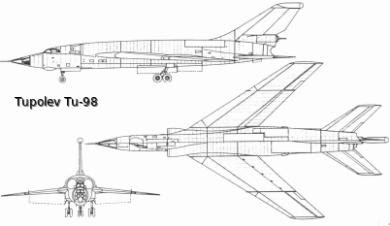The Tupolev Tu-98 was a Soviet prototype for a strategic long range bomber to replace the Tu-95 Bear. It was designed by the State-run factory Tupolev but only two were built and they never entered service. At the end of 1952, the Kremlin had issued a requirement for a bomber capable of flying at supersonic speed at high altitude over the target area. The first of the two prototypes was finally built and tested in 1956.
Technical Charasteristics
The Tu-98 was a large, streamlined supersonic aircraft, which was fitted with mid-mounted swept wings and low-mounted tailplanes. It was equipped with a conventional tricycle landing gear, which retracted backwards, with hydraulic steering. It had an internal bomb bay and a pressurized cabin, which lodged the navigator/bomb aimer, the pilot, and the radio operator/gunner. The fuselage was all-metal and the fuel tanks were located in the wings, with total fuel storage capacity being 23,500 liters. The air ducts were located one on each side of fuselage above the wings. It was powered by two Lyulka AL-7F turbojet engines.
Specifications
Length: 32 m
Wingspan: 17.3 m
Wing area: 87.5 m²
Height: 8 m
Maximum Speed: 1,365 km/h (Mach 1.1)
Range: 2,450 km
Below, the design drawing of the Tupolev Tu-98.
The one of two prototypes that were ever built, but only one flew.




